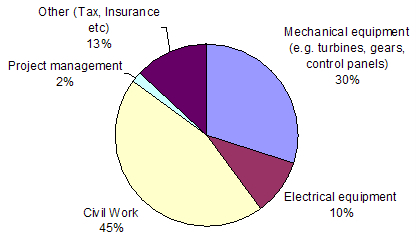Hydro Resource Evaluation Tool
economic assessment
You should ask the following questions while assessing the viability of a project:
- What is the overall project cost?
- What is the price per kWh of electricity produced?
- What is annual revenue?
- What are depreciation rate and annual maintenance provision?
- What is a reasonable discount rate or alternatively a payback period?
- What is regulatory environment?
- What are opportunities for subsidiary and other financial issues
The decision to develop a hydro power project is made on economic grounds, but is informed by factors including the environmental, cultural and physical characteristics of the site and the costs and availability of technological and engineering solutions. While the capital costs of hydro plant installation are high, operating and maintenance costs are low (1-4%), which means that a large proportion of the project’s overall budget will be spent at the development stage [Fig. 2.1]. It is therefore important to balance the cost installation against the magnitude and speed of energy output (and its value) to evaluate whether the project is worth pursuing, and if so, to plan the subsequent budget.

Fig.1 Breakdown of capital costs of a small-scale hydro plant
The viability of each hydro project is site-specific and dependent on the local characteristics. The amount of the power produced depends on the water flow, the hydraulic head and the efficiency of the device; the flow will vary through the year and the efficiency will change in response to the variation. This is covered in more detail in the ‘River Flow Availability’ and ‘Engineering Options’ sections .
Two different approaches can be used to estimate the costs of hydro plant development.
The first approach is based on the basic principles of economic analysis of investment projects. The criteria used are the following: payback period, Net Present Value (NPV) and Internal Rate of Return (IRR). This approach indicates an upper bound to a likely outlay.
The alternative approach is based on cost data analysis, using primary cost data which were recently obtained from a range of turbine manufacturers as well as secondary data. This approach is based on the idea that it is possible to establish a link between specific characteristics of a hydro site such as head and flow on one hand and the overall cost of a hydro plant development together with disaggregated costs like a cost of electro-mechanical equipment or turbine costs on the other. This approach provides an indication of a lower bound to a likely outlay.



